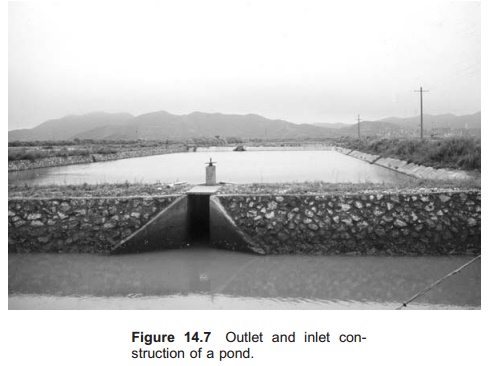Chapter: Aquaculture Engineering : Ponds
The outlet - drainage for Aquaculture Pond
The outlet - drainage
How the outlet
is constructed depends on whether or not there is a collection basin for the
fish, and if this is inside or outside the pond. The design of the level
control will also influence the construction of the outlet system. If open
channels are used, there are separate ones for the outlet water and level
control.
Normally a
standpipe inside the pond functions as a level control. The water has to pass
through this standpipe, which may be variable or fixed, to flow out of the
pond. A swivel can be used to control the level of the standpipe; this will
again control the water level in the pond. If using a double standpipe, it is
possible to take the outlet water from some depth in the pond. The standpipe
and level control may also be placed outside the pond.
Special
material must be used at the end of the outlet pipe to prevent erosion when
tapping down the pond (shock tapping); concrete is usually used here. Concrete
can also be used to construct the collecting basin for fish so that fry can be
harvested or collected. When the outlet pipe is laid through the pond levee it
is important to use mooring blocks, for instance of concrete, which are clamped
on the pipe to prevent it being dragged out by the frictional forces of the
water on the pipe. When both the flow rate and velocity are high, this is
especially critical.
If channels are
used for drainage, a specially design outlet is commonly placed in a small
channel where the water leaves the pond; this is known as a weir gate or monk
(Fig. 14.7). It is normally constructed with two plates vertically installed in
the channel, like hatches. The water has to pass below the first and above the
second. The level of the second controls the level in the pond. From the pond
the outlet water continues through a common drainage channel out of the farm.
For large water flows open channels represent a simple cost effective solution.

The methods chosen for handling the fish may influence the construction of the pond and hence the outlet system. To collect the fish from the pond it is normal to either reduce the water level with the help of the outlet or to use a seine net, or eventually a combination of both methods. When using water reduction as a collection system, a collection basin, either inside or outside the pond, can be used to collect the fish. If the basin is inside the pond it is normally small and at the bottom of the pond; it is commonly made of concrete or wooden planks. The outlet pipe from the pond is taken out from this basin. When the fish have been collected they can be removed from the basin using a net, pump or screw. The other possibility is to have the collection basin outside the pond. In this case the fish are tapped directly out of the pond together with the water and collected in the external collection basinBoth these solutions improve capacity and reduce the cost of fish handling.
A seine net may
also be used for collection. Typically it is dragged through the pond and the
fish are collected. The net can be hauled from the pond levees. If the pond is
too wide, this will, however, be quite difficult, so widths of more than 20 m
are not recommended. The seine net may also be dragged mechanically, for
instance by a tractor.
Related Topics